17.09.2022
Vandenberg’s final Delta IV Heavy rocket launch to take place at end of September
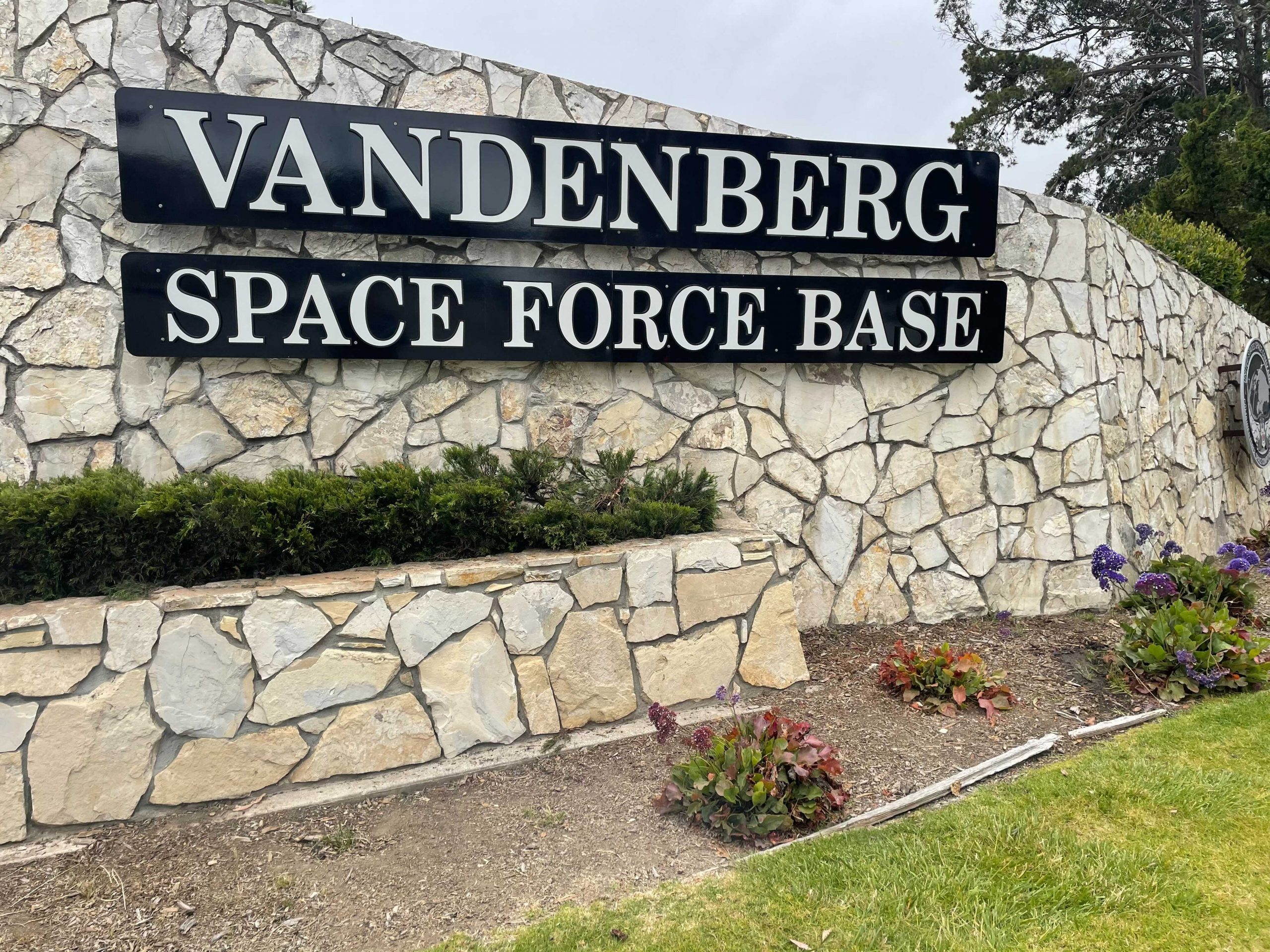
VANDENBERG, Calif. – A National Reconnaissance Office mission (NROL-91) aboard a United Launch Alliance Delta IV Heavy rocket is set to take off from Vandenberg Space Force Base on the afternoon of Sept. 24.
"NROL-91 is the latest national security payload to deliver critical intelligence information from space that U.S. warfighters and decision makers need," Space Force Base officials said, adding that NRO capabilities provide the foundation for America's advantage and strength in space.
The Delta IV Heavy rocket – a heavy-lift launch vehicle –is the largest type of the Delta IV family and one of the world's most powerful rockets, officials said. It has had 13 successful launches and is the world's second-highest payload weight capacity rocket in operation.
The launch window for the Sept. 24 launch from Vandenberg's Space Launch Complex-6 opens at 1:50 p.m. Col. Bryan Titus will be the launch decision authority.
It will be the 10th Delta IV launch from Vandenberg, and the fifth and final heavy variant from Vandenberg Space Force Base.
Quelle: abc News
+++
DELTA IV HEAVY TO LAUNCH NROL-91

A United Launch Alliance (ULA) Delta IV Heavy rocket will perform the NROL-91 mission in service to the National Reconnaissance Office (NRO) and the Space Force's Space Systems Command (SSC). Liftoff will occur from Space Launch Complex-6 at Vandenberg Space Force Base, California.
Launch Date and Time: Sept. 24, 2022 between 1:50-4:12 p.m. PDT
Go Delta! Go NROL-91!
Quelle: ULA
----
Update: 22.09.2022
.
ULA readies Delta 4-Heavy rocket for weekend launch from California
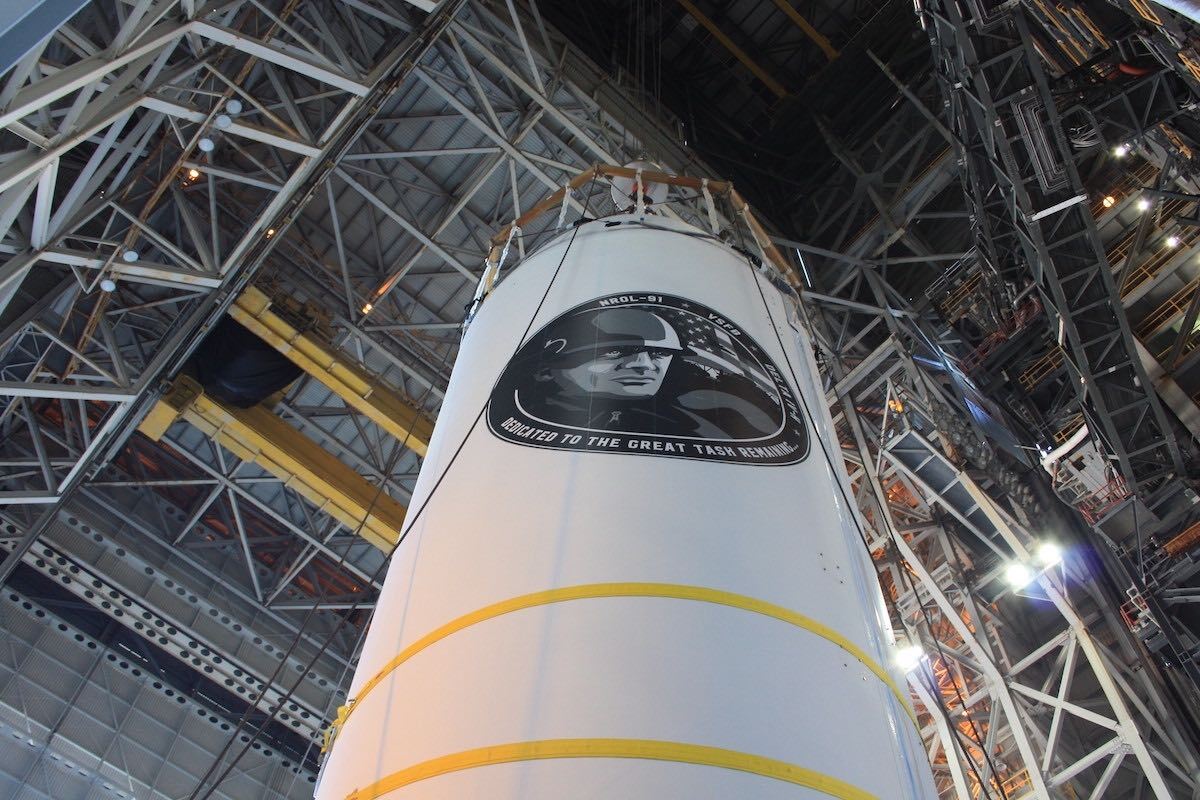
The payload fairing containing the National Reconnaissance Office’s classified spy satellite is lifted atop ULA’s Delta 4-Heavy rocket before the NROL-91 mission. Credit: United Launch Alliance
United Launch Alliance’s ground team recently completed a countdown dress rehearsal and installed a classified spy satellite payload on top of a Delta 4-Heavy rocket at Vandenberg Space Force Base in California, readying the triple-body launcher for liftoff Saturday.
The top secret spy satellite on top of the Delta 4-Heavy rocket is likely a new sharp-eyed electro-optical Keyhole-type imaging platform for the NRO, according to independent analysts. But the NRO has not disclosed details of the satellite, keeping with the spy agency’s policy of not commenting on details of its missions.
The Delta 4-Heavy rocket is set to blast off from Space Launch Complex-6, a sprawling launch pad on the southwestern edge of Vandenberg overlooking the Pacific Ocean, at 2:53 p.m. PDT (5:53 p.m. EDT; 2153 GMT) Saturday, according to ULA and the NRO. Officials previously said the launch window extends from 1:50 p.m. to 4:12 p.m. PDT.
The mission Saturday is codenamed NROL-91, and will mark the final Delta 4 launch from Vandenberg. It will be the third-to-last flight overall for the Delta rocket family, which ULA is retiring in favor of the next-generation Vulcan Centaur rocket. The Vulcan rocket will replace ULA’s Atlas and Delta rocket fleets.
The final Delta 4 launches are scheduled for 2023 and 2024 from Cape Canaveral. Those missions will also haul top secret spy satellites into orbit for the NRO.
Maritime exclusion zones published as part of public navigation warnings suggest the Delta 4-Heavy on the NROL-91 mission will fly south-southeast from Vandenberg over the Pacific Ocean. Based on publicly available data, analysts estimate the mission will aim to place its classified cargo into low Earth orbit at an latitude of around 250 miles (400 kilometers) and an inclination of approximately 74 degrees to the equator.
Those parameters closely match a previous Delta 4-Heavy rocket launch for the NRO in January 2019, designated NROL-71.
The Delta 4-Heavy is the most powerful rocket in ULA’s fleet of operational rockets. Engineers designed the rocket with three Delta 4 rocket core bolted together, each powered by an RS-68A engine produced by Aerojet Rocketdyne. The Delta 4-Heavy’s main engines will produce about 2.1 million pounds of thrust at liftoff, powering the launcher faster than the speed of sound in 81 seconds as it soars downrange over the Pacific Ocean.

The core stage engine will throttle down its RS-68A engine to a partial thrust setting, conserving its supply of liquid hydrogen and liquid oxygen propellants while the side boosters fire at full throttle. The side boosters will shut down their RS-68A engines and jettison about four minutes into the mission, falling to predetermined drop zones in the Pacific. The core stage will burn until around about five-and-a-half minutes into the flight, then jettison to yield to the Delta 4’s hydrogen-fueled upper stage.
The upper stage will fire its RL10 engine moments later, and the rocket will release its nose fairing into a clamshell-like motion, revealing the top secret NRO satellite to space for the first time. At that point, the NROL-91 mission will enter a government-imposed news blackout, with ULA ending live coverage of the launch.
The rest of the mission through payload deployment will occur in secret. ULA and the NRO are expected to release a statement once the NROL-91 payload separates from the Delta 4’s upper stage.
ULA technicians assembled the Delta 4-Heavy rocket in a Horizontal Integration Facility near the SLC-6 launch pad after the first stage boosters and upper stage were delivered to California last year from the company’s factor in Decatur, Alabama. Ground teams rolled the Delta 4-Heavy to the SLC-6 launch pad earlier this year, then raised it vertical for a countdown dress rehearsal that involved loading cryogenic propellants into the rocket.
With that milestone complete, ULA recently installed the top secret NROL-91 payload atop the Delta 4-Heavy to cap off stacking of the 233-foot-tall (71-meter) rocket inside the launch pad’s mobile service gantry, which will retract away from the vehicle during Saturday’s countdown.
The NROL-91 launch will be the 43rd flight of a Delta 4 coat since 2002, and the 14th launch in the Delta 4-Heavy configuration since 2004. It’s also the 95th and final launch by the Delta rocket family from Vandenberg, and the 10th and final Delta 4 launch from the California spaceport.
There are no future users currently lined up for the SLC-6 launch pad after Saturday’s launch. Nestled among hills that hide the pad from public view, SLC-6 was originally constructed to support flights of military astronauts and NASA space shuttles.

NASA’s space shuttle Enterprise, used for ground demonstrations and atmospheric test flights, was stacked on the SLC-6 launch with external tank and solid rocket booster test articles for fit checks in early 1985.
But the Air Force abandoned plans to launch military space shuttle flights from Vandenberg in the wake of the Challenger accident in 1986, and the shuttle-era buildings at the SLC-6 site sat mothballed for years. Lockheed Martin used the SLC-6 pad for four launches of its light-class Athena rockets in the 1990s, but those missions didn’t utilize much of the shuttle-era infrastructure at the site.
Boeing took over the SLC-6 pad and modified the shuttle infrastructure for the Delta 4 rocket, which first launched there in June 2006. ULA was formed later in 2006 by the merger of Boeing’s Delta and Lockheed Martin’s Atlas rocket programs.
Northrop Grumman planned to use the SLC-6 launch pad for its planned OmegA rocket, which the company proposed to the Pentagon in a competition for military launch contracts. But the Defense Department selected ULA’s Vulcan rocket and SpaceX’s Falcon 9 and Falcon Heavy launchers in 2020 for eligibility to compete for military launches scheduled through 2027.
Northrop Grumman shut down development of the OmegA rocket after losing the military launch procurement.
Quelle: SN
----
Update: 25.09.2022
.
ULA’s Delta 4 prepares for final West Coast launch as Vandenberg seeks new tenants
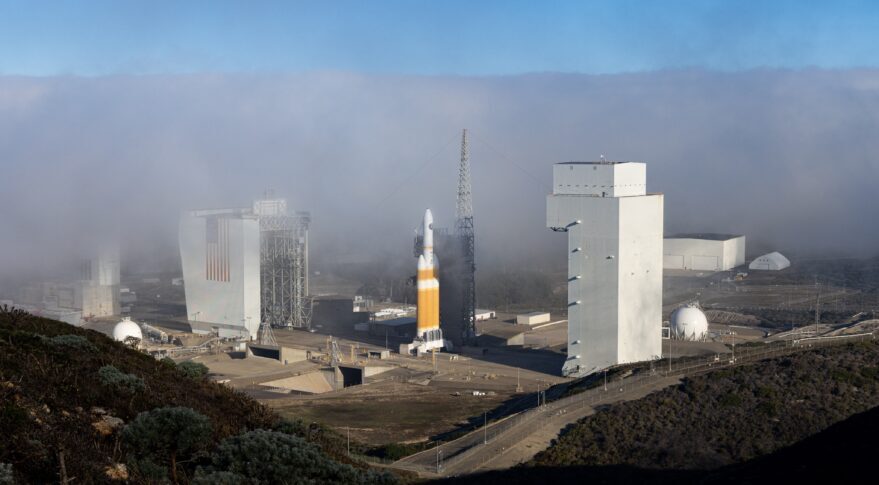
WASHINGTON — A United Launch Alliance Delta 4 Heavy rocket is scheduled to launch a National Reconnaissance Office mission Sept. 24 from Space Launch Complex-6 at Vandenberg Space Force Base, California.
This will be Delta 4’s final launch from the West Coast. ULA is under contract to launch two more missions on the Delta 4 Heavy in 2023 and 2024, but will fly those from Cape Canaveral, Florida, after which the vehicle will be retired.
The launch of NROL-91 marks the end of an era, Col. Chad Davis, the NRO’s director of the Office of Space Launch, told reporters Sept. 22. “I think bittersweet is absolutely the right word to use with that.”
After completing the NROL-91 mission, ULA plans to start vacating the pad, known as Space Launch Complex-6. The company’s future vehicle, Vulcan Centaur, will launch from Vandenberg’s Space Launch Complex-3, from which ULA currently flies its Atlas 5 rocket.
During a call with reporters, Col. Bryan Titus, vice commander for Space Launch Delta 30 at Vandenberg, said range officials are in active discussions with launch companies to try to get a new tenant for SLC-6.
Space Launch Delta 30 is the Space Force unit that operates the Vandenberg range.
“I’m fairly confident that it will be utilized,” Titus said of SLC-6. He declined to name any potential tenants.
Most launches at Vandenberg today are conducted by SpaceX, which leases Space Launch Complex-4for launches and booster landings.
Titus noted SLC-6’s storied past. It was originally built in the 1960s to launch the Air Force’s never-flown Manned Orbital Laboratory, and repurposed in the 1980s as a dedicated launch and landing site for military space shuttle missions. After the 1986 Space Shuttle Challenger disaster, the Air Force mothballed the site without ever conducting a West Coast shuttle launch. It reactivated the site in the 1990s for a handful of Lockheed Martin Athena launches and eventually turned it over to the Delta 4 program. SLC-6’s runway has been used to land the Air Force’s X-37B reusable spaceplane.
Blue Origin and Northrop Grumman reportedly considered working out an arrangement with ULA to use SLC-6 to launch national security missions had they been selected for the National Security Space Launch Phase 2 contract. But both were edged out by ULA and SpaceX in August 2020.
The pad “has had many lives,” said Titus. “I think everyone at Vandenberg has a warm spot in their hearts for that place, and we’re going to make sure it’s continued to be utilized, but we don’t know exactly how,” he added. “There are many other launch service providers out there that could find utility in that location. There’s a lot of infrastructure there.”
Gary Wentz, ULA’s vice president of government and commercial programs, said the company is preparing for Atlas 5’s final West Coast launch from SLC-3 scheduled for November 1. That will be the Joint Polar Satellite System 2 polar-orbiting weather satellite, developed by NASA and the National Oceanic and Atmospheric Administration.
After that mission is completed, SLC-3 will be outfitted with new equipment in preparation for Vulcan, which is projected to start flying in 2023.
He said ULA did not see a need to keep two launch pads on the West Coast. “From a business perspective, it was appropriate for us to use SLC-3 because there was a lot of commonality between Atlas and Vulcan systems.”
Quelle: SN
+++
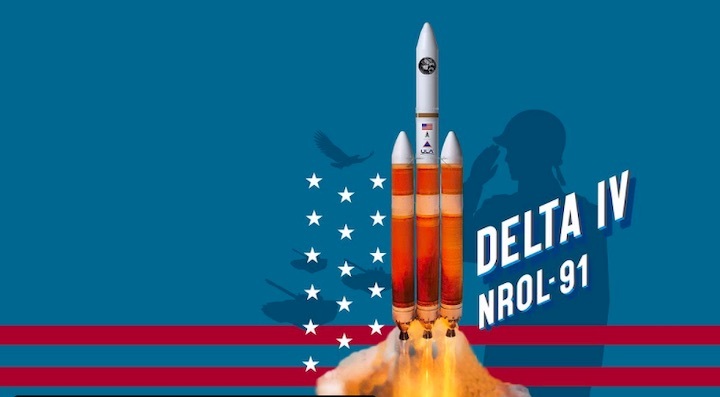
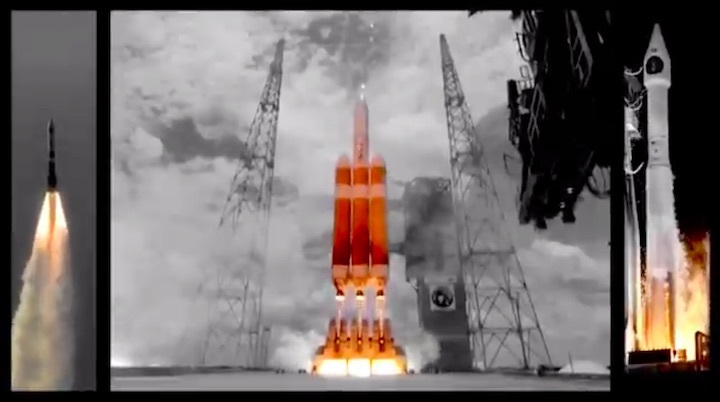
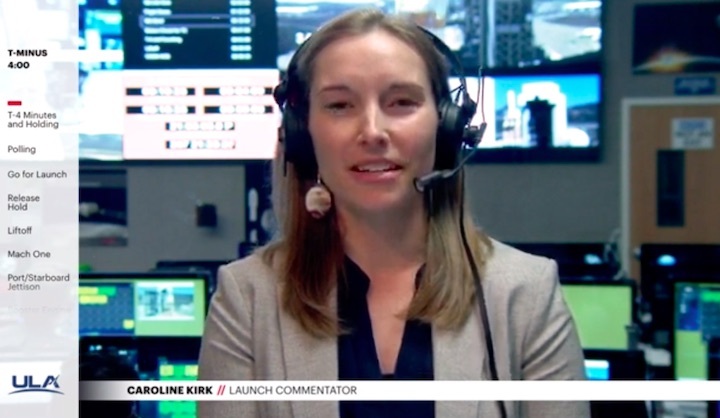
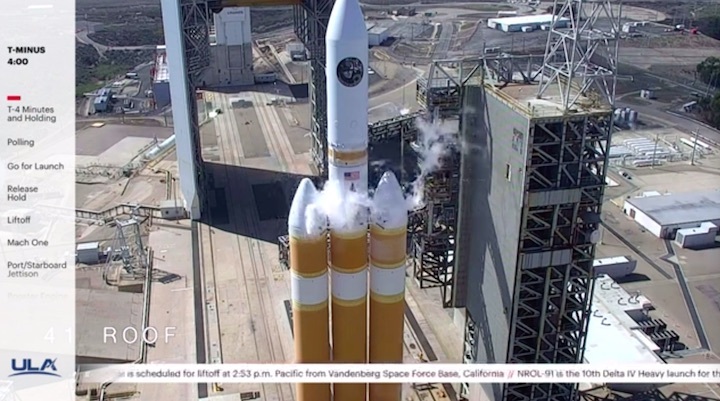

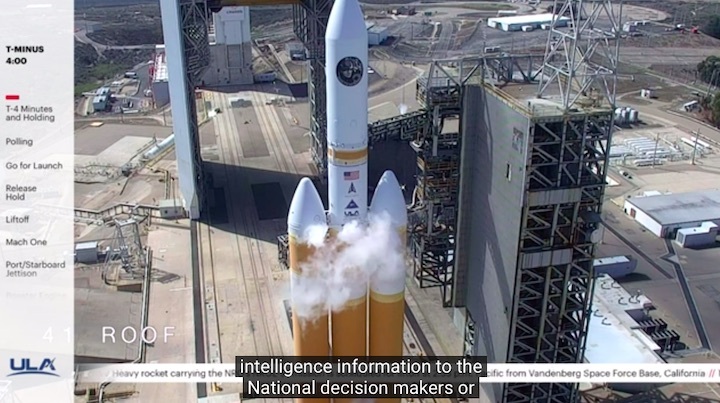
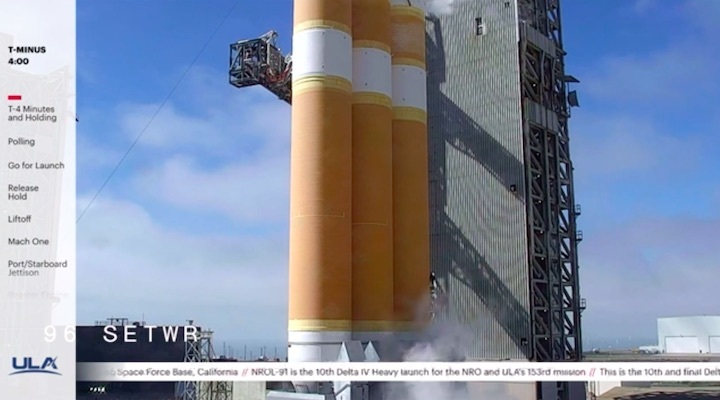

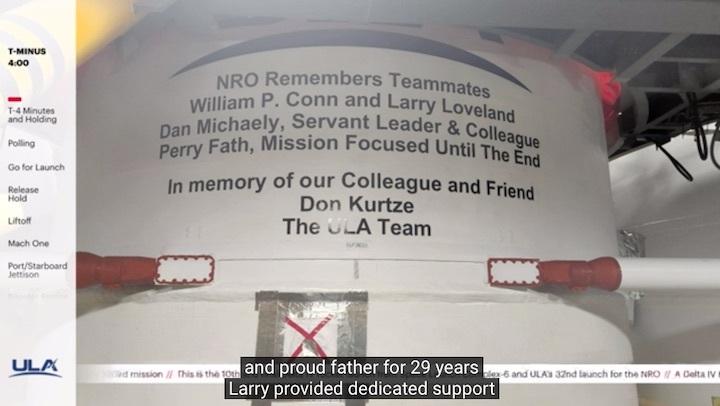

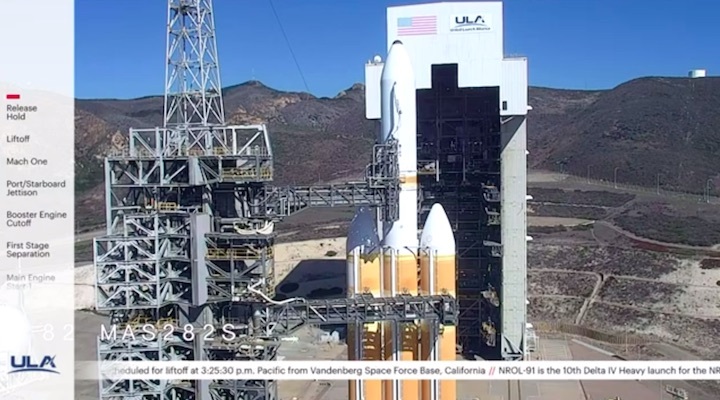
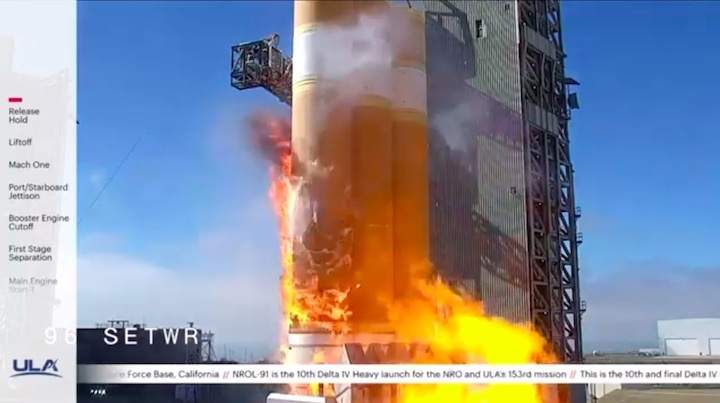
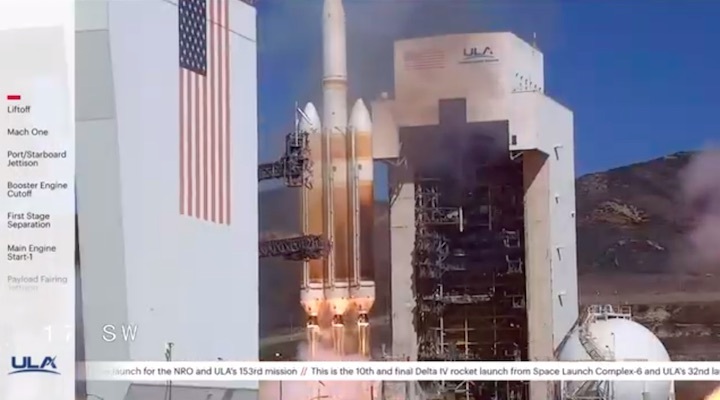
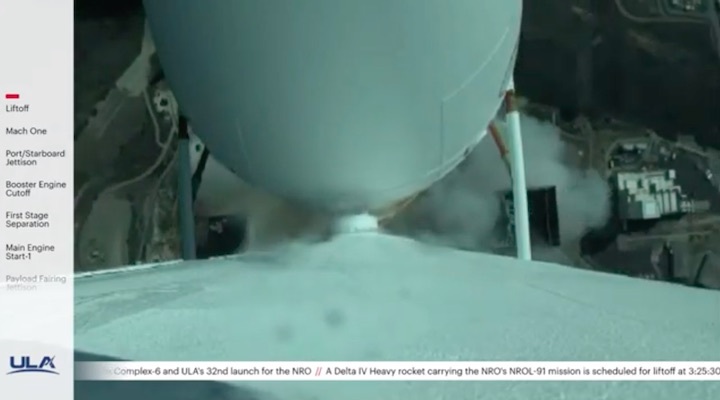
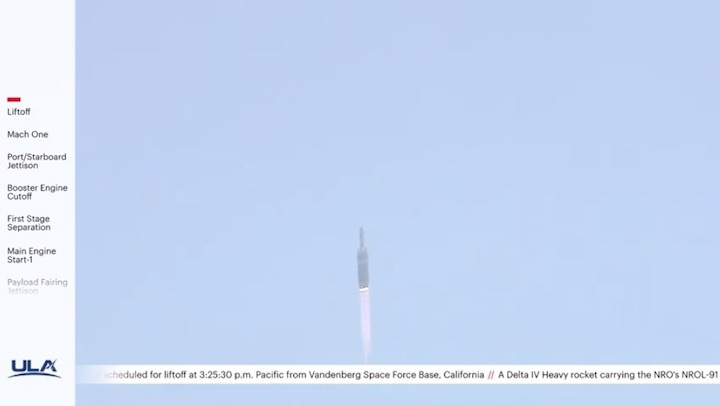
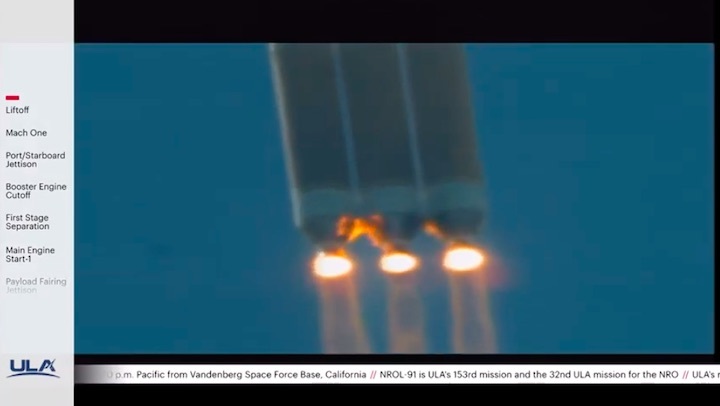
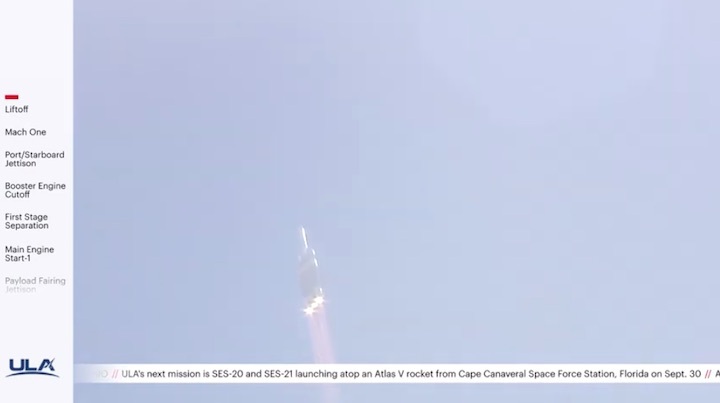
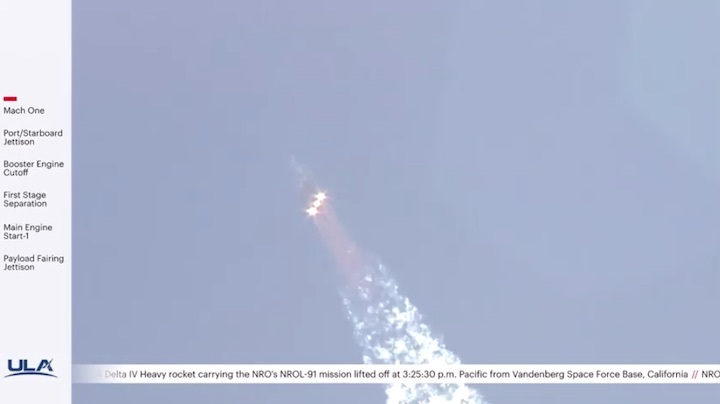
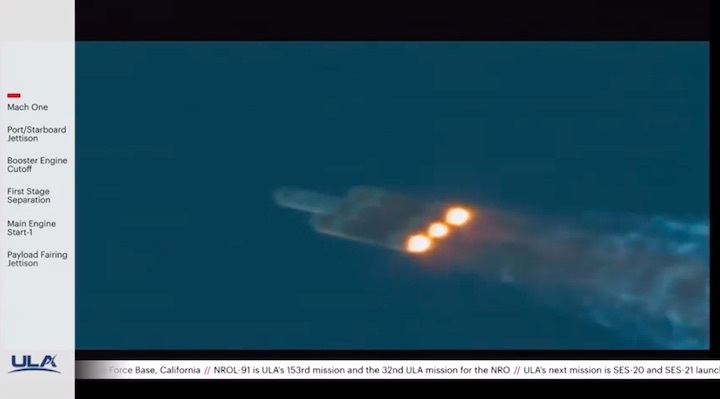
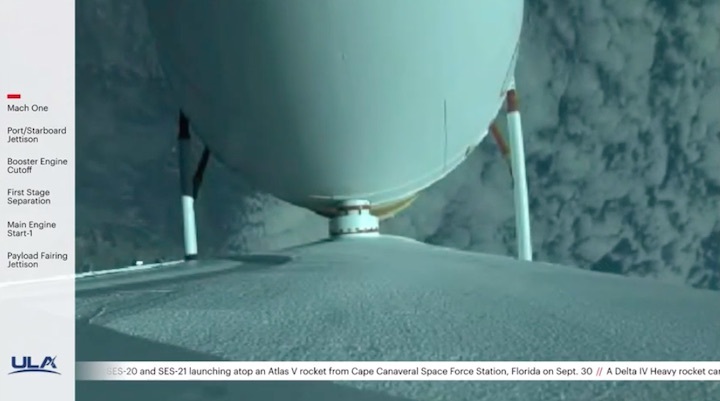
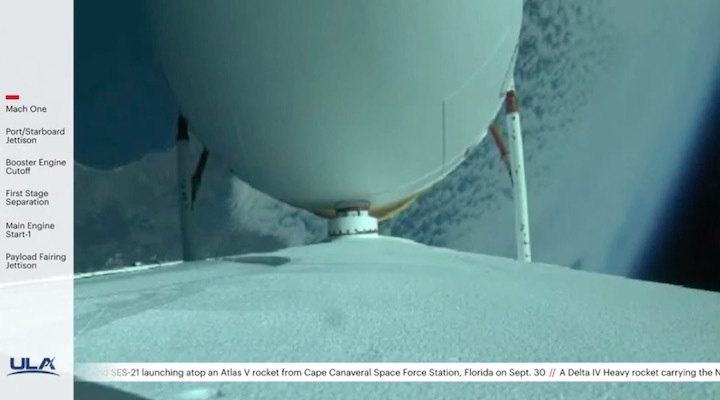
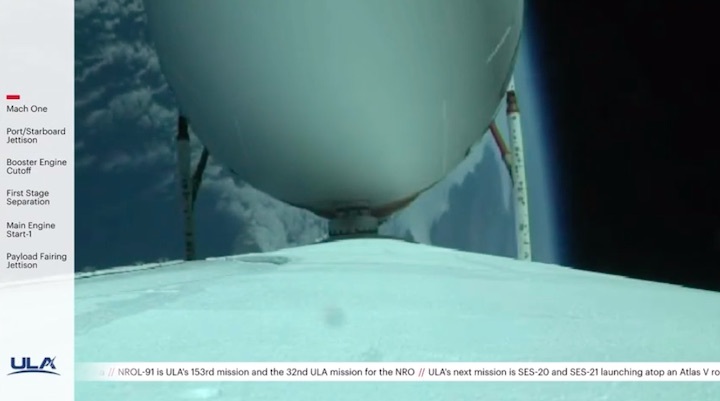
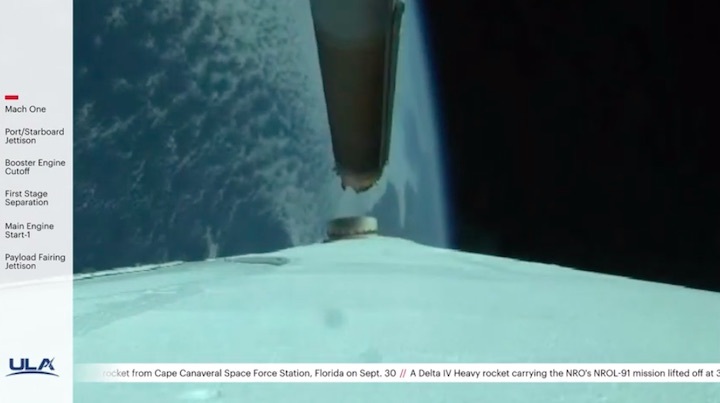
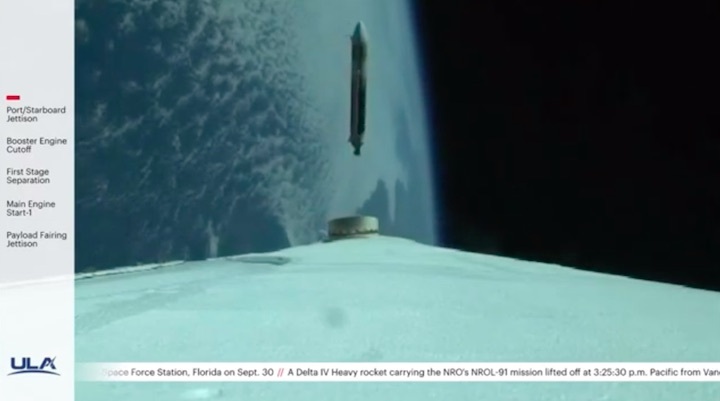
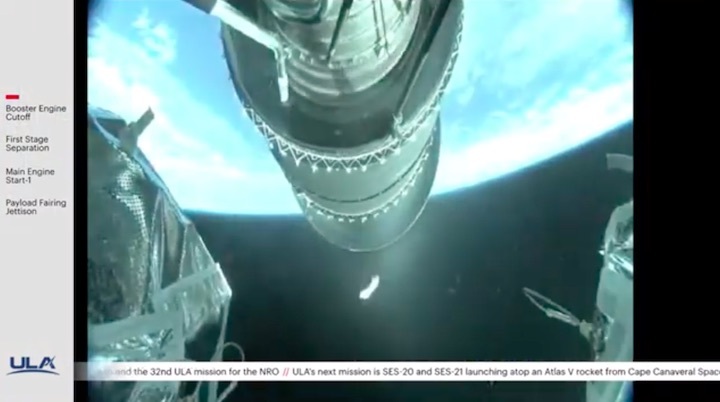
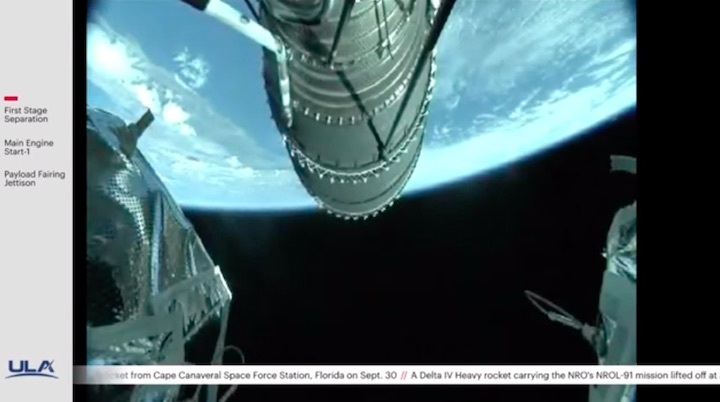

Quelle: ULA
----
Update: 26.09.2022
.
NRO satellite flies to orbit in Delta 4’s final West Coast launch

WASHINGTON — United Launch Alliance launched a classified National Reconnaissance Office spy satellite on a Delta 4 Heavy rocket September 24 at 3:25 p.m. Pacific from Space Launch Complex-6 at Vandenberg Air Force Base, California.
NROL-91 is the Delta 4’s final mission from the West Coast. The vehicle last flew in April 2021 when it launched NROL-82.
About four minutes into flight, the outer boosters of the three-core Delta 4 Heavy separated. The second stage separated about two minutes later.
At the request of the NRO, ULA ended the webcast nearly seven minutes into the flight after the nose fairing was jettisoned.
NROL-91 was the 10th mission Delta 4 Heavy launched for the NRO. The vehicle has flown 43 missions overall and 14 in the Heavy configuration.
Each of the Delta 4 Heavy’s common booster cores is powered by Aerojet Rocketdyone’s RS-68A main engines. The Delta cryogenic second stage is powered by an RL10C-2-1 engine. The rocket uses liquid hydrogen and liquid oxygen in all stages.
The U.S. Space Systems Command and the NRO confirmed in a news release that the mission was successful. “The Delta 4 Heavy has proven to be an integral part of the NRO’s history, helping us build the architecture for the world’s best space-based intelligence, surveillance and reconnaissance,” said NRO Director Chris Scolese. “As our agency and the aerospace industry continue to innovate and evolve, we will explore new vehicles for launching payloads even more efficiently and effectively.”
ULA is under contract to launch two more NRO satellites on the Delta 4 Heavy in 2023 and 2024 but these will launch from Cape Canaveral, Florida. ULA then plans to retire the Delta 4 Heavy and replace it with the new Vulcan Centaur rocket.
Quelle: SN
